
Original Link: https://www.anandtech.com/show/5787/ibuy-power-erebus-gt-review-ivy-bridge-and-nvidias-geforce-gtx-680-in-sli
iBUYPOWER Erebus GT Review: Ivy Bridge and NVIDIA's GeForce GTX 680 in SLI
by Dustin Sklavos on April 27, 2012 2:00 AM ESTRe-Introducing the iBUYPOWER Erebus GT
It was only a month-and-a-half ago that we were able to test the iBUYPOWER Erebus GT, a boutique desktop with a custom water-cooling loop at a very compelling price for what you got. Yet in the intervening period the computing landscape has actually changed fairly drastically, with NVIDIA's GeForce GTX 680 coming to market and Intel releasing the Ivy Bridge-based Core i7-3000 series processors. Our previous review unit focused more on value proposition with a single AMD Radeon HD 7970 handling graphics duties, but the one we have on hand today is a true war machine.
We've covered Ivy Bridge extensively up to its launch and exhaustively this week, with a breakdown of the architecture and performance, analysis of its overclocking potential, testing in an HTPC environment, benching the notebook version, and even a vendor discussion and Q&A with ASUS of the Z77 platform that accompanies it. Today we have a firsthand look at how Ivy Bridge is going to handle and overclock in the field courtesy of an updated Erebus GT from iBUYPOWER, along with our first taste of a pair of NVIDIA GeForce GTX 680 graphics cards in SLI running on the platform.
.jpg)
There's no question that Intel's made a major achievement with Ivy Bridge: IPC is up, power consumption and die size are down, so that's pretty much win-win for all involved. Yet there's one discipline Sandy Bridge has excelled in that Ivy Bridge has a bit harder of a time with: overclocking.
The Erebus GT system that was equipped with Sandy Bridge was able to hit a 4.6GHz overclock on the Core i7-2700K, while the refreshed system with a Core i7-3770K is only able to go up to 4.4GHz, and we expect this is going to be about as high as Ivy Bridge is going to consistently go. So the question becomes: are the IPC improvements in Ivy Bridge enough to make up for the reduced overclocking headroom? We'll find out in a moment, but first here's the rundown of the updated Erebus GT.
| iBUYPOWER Erebus GT Specifications | |
| Chassis | iBUYPOWER Custom |
| Processor |
Intel Core i7-3770K (4x3.5GHz + HTT, Turbo to 3.9GHz, 4.4GHz Overclock, 22nm, 8MB L3, 77W) |
| Motherboard | ASUS Sabertooth Z77 (Z77 Chipset) |
| Memory | 4x4GB Corsair Vengeance DDR3-1600 (expandable to 32GB) |
| Graphics |
2x NVIDIA GeForce GTX 680 2GB in SLI 2x (1536 CUDA cores, 1006/6008MHz core/RAM, 256-bit memory bus) |
| Storage |
Intel 520 120GB SATA 6Gbps SSD (SF-2281) Seagate Barracuda 7200.12 2TB 7200-RPM SATA 6Gbps HDD |
| Optical Drive(s) | Hitachi-LG BD-ROM/DVD-RAM |
| Power Supply | Corsair AX1200 80 Plus Gold |
| Networking | Intel 82579V Gigabit Ethernet |
| Audio |
Realtek ALC892 Speaker, mic/line-in, surround jacks, optical out for 7.1 sound |
| Front Side |
Optical drive SD card reader 2x USB 2.0 2x USB 3.0 Headphone and mic jacks 6-channel fan controller |
| Top | - |
| Back Side |
4x USB 2.0 HDMI (IGP) DisplayPort (IGP) Optical out 2x eSATA 4x USB 3.0 Ethernet Speaker, mic/line-in, surround, and optical jacks 4x DVI-D (2x GTX 680) 2x HDMI (2x GTX 680) 2x DisplayPort (2x GTX 680) |
| Operating System | Windows 7 Home Premium 64-bit SP1 |
| Extras |
Card reader Custom liquid-cooling loop Custom LED lighting 80 Plus Gold modular PSU |
| Warranty | 3-year parts, lifetime labor and support |
| Pricing | ??? |
Compared to the last unit we reviewed, we're looking at what theoretically could be a wash in terms of CPU performance (4.6GHz i7-2700K vs. 4.4GHz i7-3770K), but pretty dramatic improvements most everywhere else. The ASUS Sabertooth Z77 leverages the i7-3770K's PCIe 3.0 support along with USB 3.0 connectivity, and it includes Intel's highly desirable gigabit ethernet NIC as opposed to the Realtek controller more commonly found.
The other elephant in the room, or elephants, are the pair of NVIDIA GeForce GTX 680 cards in SLI. NVIDIA got rid of the hot shader clock in Kepler, but in the move to 28nm they also basically tripled the number of CUDA cores from GF100/110. Do some vulgar math and that works out to about 50% more shader power per GPU than the GTX 580, and you get to enjoy NVIDIA's generally excellent SLI support. That said, as has been mentioned before, the GTX 680's memory bandwidth nears 200GB/sec but still doesn't scratch the ~250GB/sec the AMD Radeon HD 7970 offers, and the GTX 680 is also working with a smaller framebuffer with 2GB of GDDR5 instead of the 7970's 3GB. Still, the 680 has been fast enough to be crowned the fastest single-GPU video card available, so theoretically two of them should be screaming fast.
Finally, we have a hefty 1200W, 80 Plus Gold power supply from Corsair, an Intel SSD, and 16GB of Corsair Vengeance DDR3 running at 1600MHz. There's very little to complain about here, the parts employed are top shelf from start to finish.
Application and Futuremark Performance
What we're essentially trying to gauge here is how an Ivy Bridge processor with reduced overclocking headroom compares to a Sandy Bridge chip with lower IPC and higher clocks. In the process, we can also see how both of them compare to chips with lower IPC and extra cores (specifically Gulftown and Sandy Bridge-E).

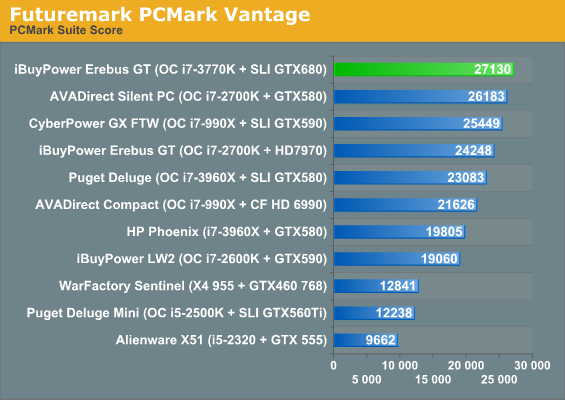
Out of the gate the PCMarks are both responding well, but I suspect that may also be due to the Intel SSD employed in this Erebus GT. It may still be using SandForce's controller, but it's Intel's firmware. Whatever the case, for general use the new Erebus GT screams through PCMarks, delivering a 7% increase in PCMark 7 and 12% in Vantage compared to the previous model.
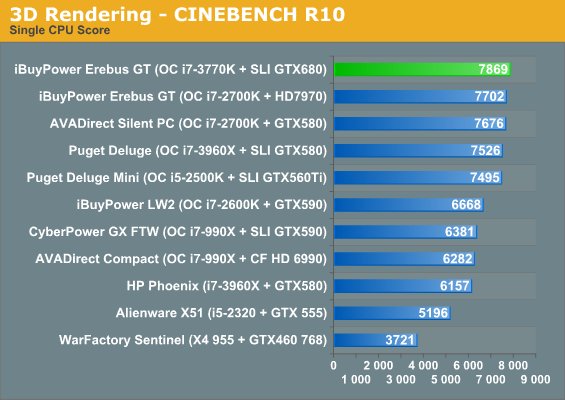
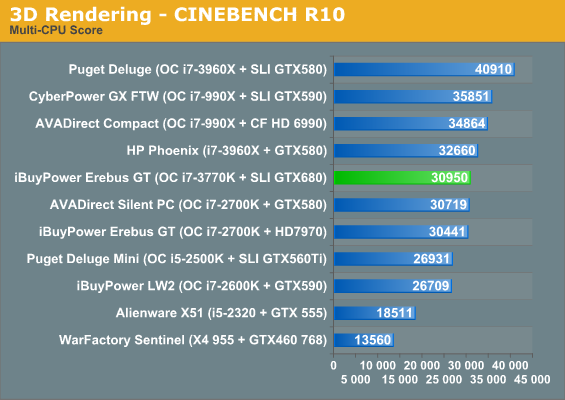
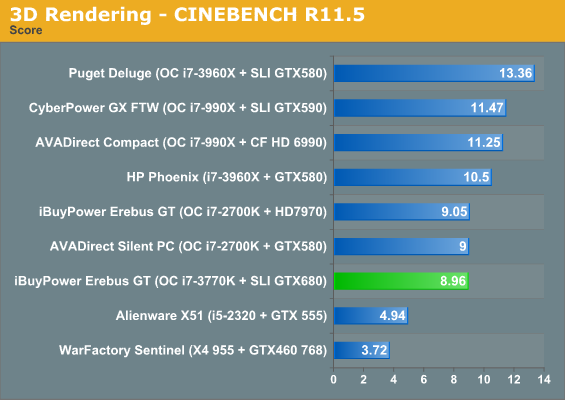
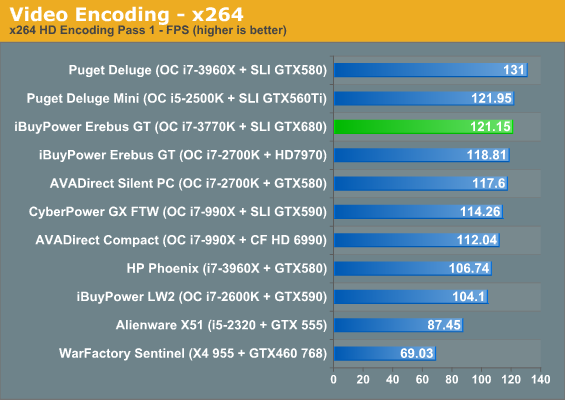
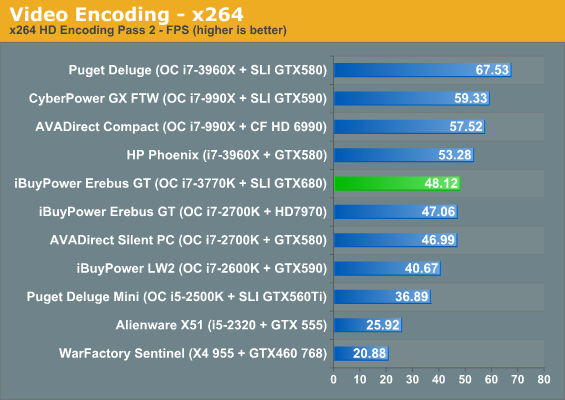
Looking at the CPU-dependent benchmarks may or may not be troubling, depending on your perspective. From the looks of things, Ivy Bridge's improved IPC is almost entirely mitigated by its reduced overclocking headroom. The IVB Erebus GT is a scant 2% faster in most of our CPU tests, with the SNB variant actually taking a slight 1% lead in Cinebench 11.5. What's interesting is that on the CPU side, even overclocking and increased IPC still doesn't bridge the gap between Intel's quad cores and their hexacores; the i7-990X still runs wild in any task that can take advantage of the extra cores.
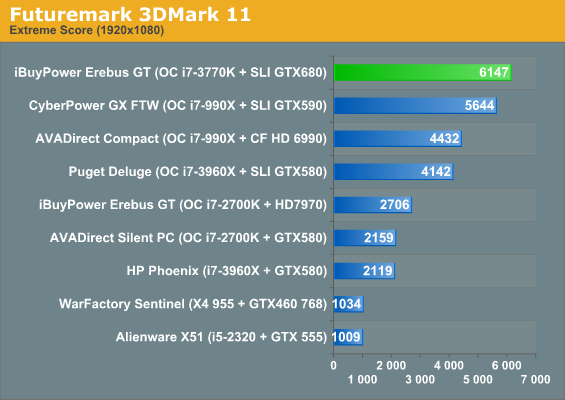
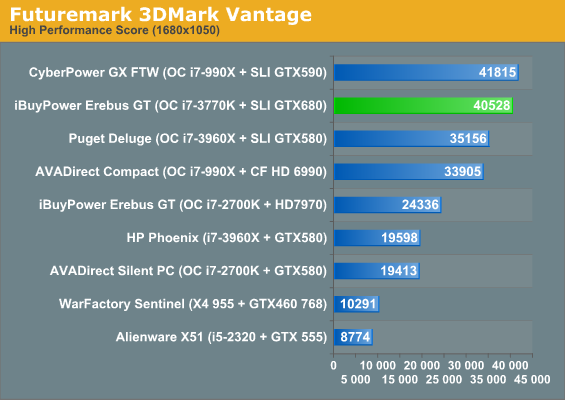
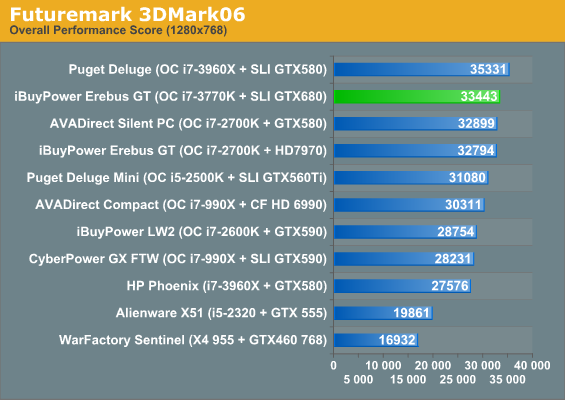
What can we take away from the 3DMark results? 3DMark06 is always going to be CPU-limited (and probably should be deprecated at this point), but in 3DMark Vantage's older workload we see a pair of GTX 680s essentially equaling the performance of two GTX 590s. That's two current generation GPUs hitting stride with four of last generation's. When you get to 3DMark11, the GTX 680s just run away with it. This is important, remember it, because it's going to come up again when we get to power consumption.
Gaming Performance
Given what we've seen on the last page of the pair of GeForce GTX 680's in the iBUYPOWER Erebus GT, it's reasonable to assume we'll see them pretty much at the top of every chart. Thankfully we're starting to accumulate a decent amount of data to draw comparisons from with our new gaming suite.
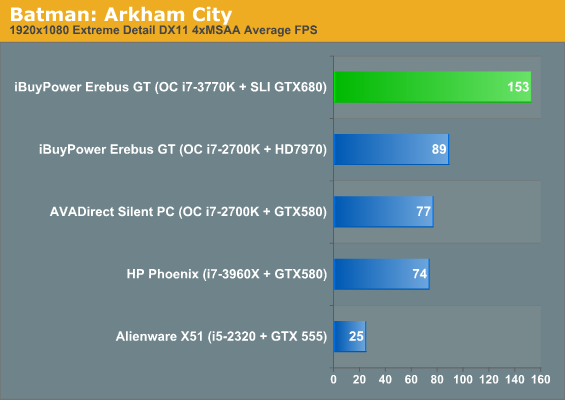

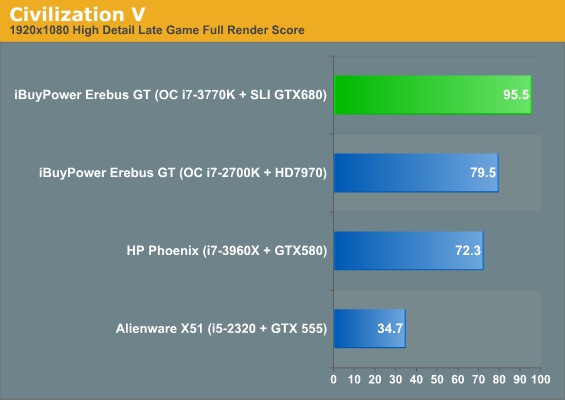
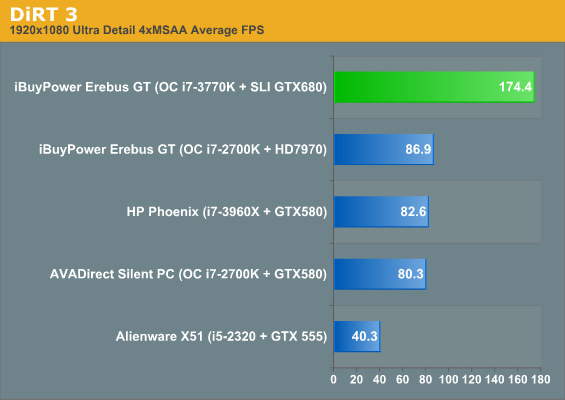
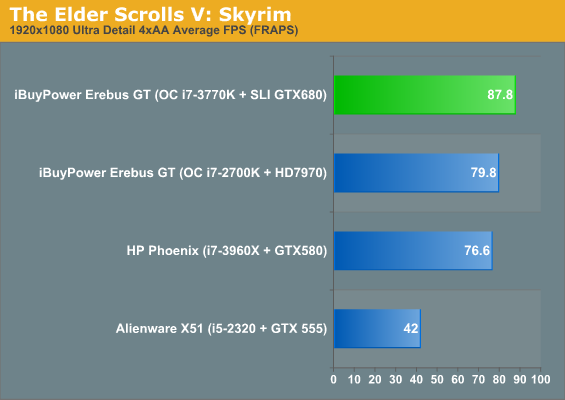

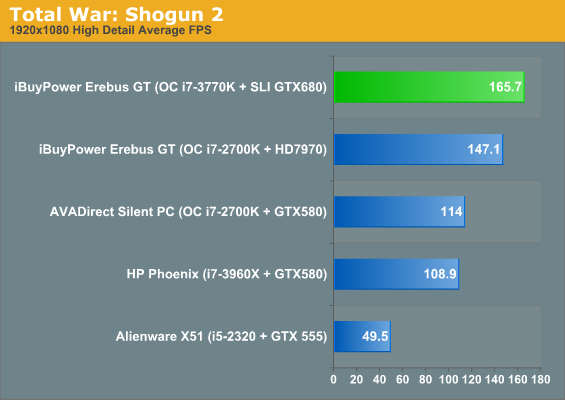
Bottom line, two GTX 680s is essentially excessive for 1080p. That's to be expected, but I was so stunned by the performance in Battlefield 3 that I actually had to double-check my results. Battlefield 3 has been fairly punishing on most of the systems I've tested, but the GTX 680s just brush it off. In other titles, we clearly hit CPU limits before the GPUs can reach their stride—Civilization V, Elder Scrolls: Skyrim, and Total War: Shogun 2 are clearly CPU limited at this point, and Portal 2 is only somewhat less so.
At the same time, everything isn't quite sunny for SLI right now. Since the GTX 680 is fairly new, each driver release from NVIDIA is going to become that much more important. The 301.10 drivers, for example, weren't entirely stable compared to the 301.24 betas, which could run DiRT 3 in surround without issue. I also had trouble actually configuring surround in the first place on the 301.10s, problems that didn't resurface in the 301.24s. The 301.10s also produced substantially lower SLI performance in Portal 2 (still 130+ fps) than the 301.24s.
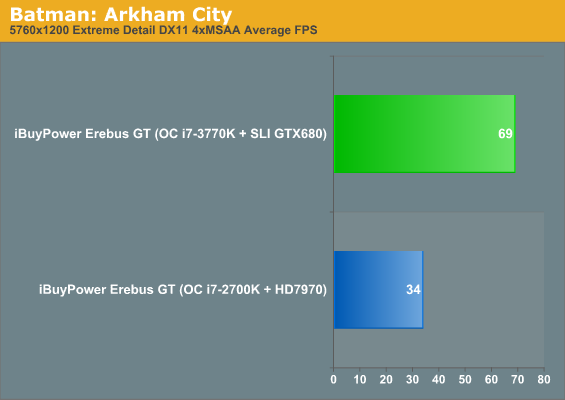
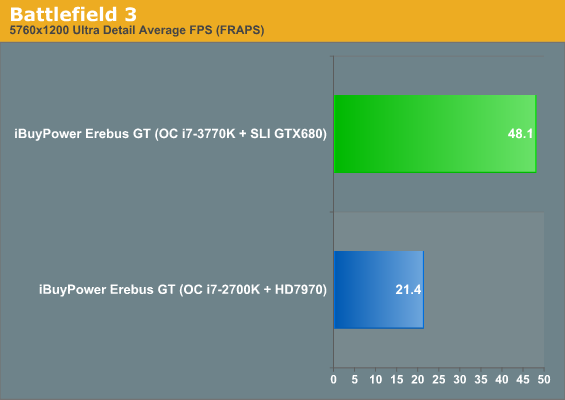
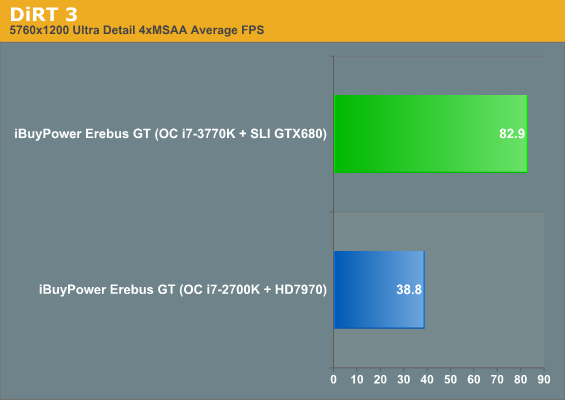
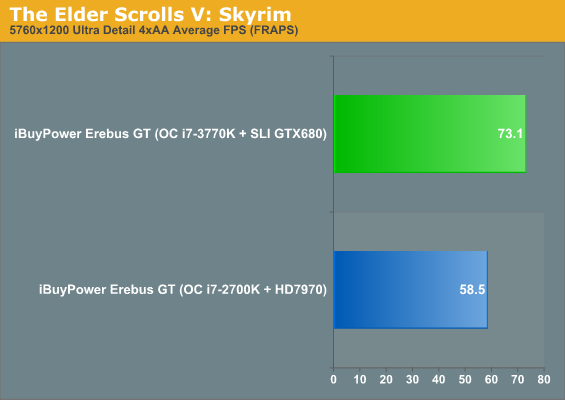

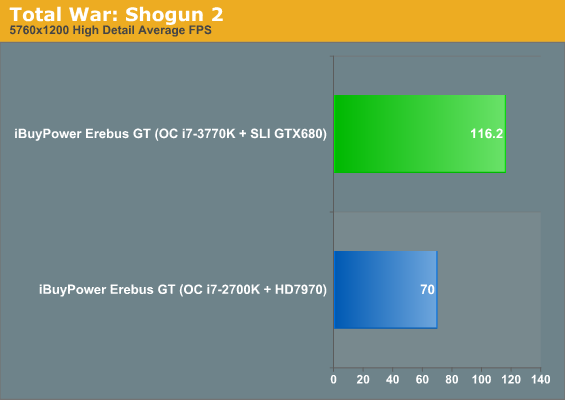
I'm sure it surprises no one that the pair of GTX 680s is able to provide playable experiences across every game at our highest resolution and settings. Battlefield 3 does bring the hammer down, though; triple the resolution and the performance is sliced pretty linearly down to about a third of what it was. If you want to run at surround resolutions with anti-aliasing enabled, though, the GTX 680s can do it. Interestingly, Skyrim is still apparently hitting CPU bottlenecks even at 5760x1200.
Build, Heat, and Noise
Given that the iBUYPOWER Erebus GT we have for review now is essentially identical in terms of build quality to the one we reviewed a month-and-a-half ago, there isn't a whole lot to update on. Build quality on this review unit was excellent, period, and the components iBUYPOWER chose were all solid, name brand selections. If anything, I think part of it might have been over-engineered.
Where things get interesting is when we look at system thermals and power draw. We've heard that Ivy Bridge runs hotter than Sandy Bridge does, and I can confirm those findings by comparing the thermal readings from our Sandy Bridge-based Erebus GT against our Ivy Bridge-based Erebus GT.
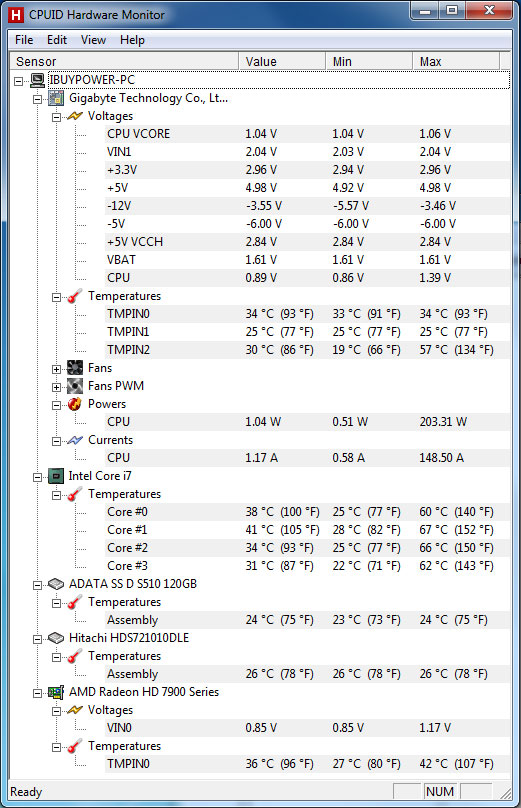
Intel Core i7-2700K-based Erebus GT
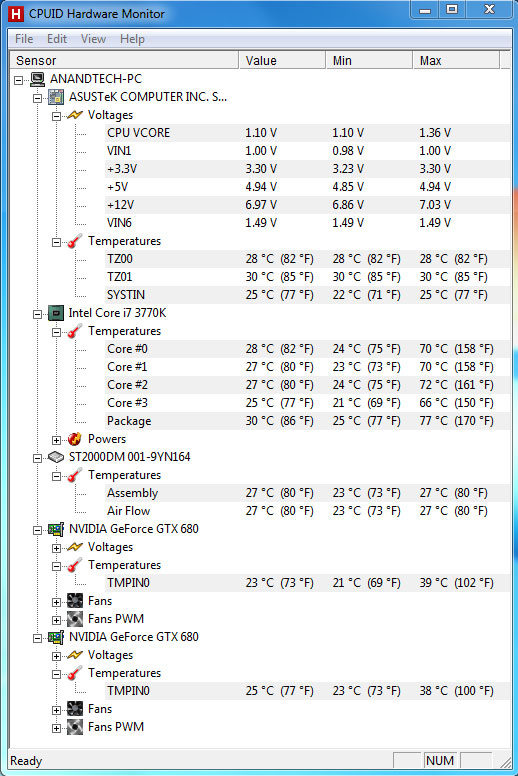
Intel Core i7-3770K-based Erebus GT
First, it's pretty obvious the water-cooling loop is doing its job on the video cards, and by doing so they give NVIDIA's GPU Boost a lot of thermal leeway. iBUYPOWER didn't overclock the GTX 680s in the Erebus GT, but odds are good you could probably eke out even more performance if you were somehow not satisfied with two GTX 680s in SLI. Second, the i7-3770K definitely runs hotter than the i7-2700K. Not by a tremendous degree, but there's a difference. Keep in mind that the ambient temperature in the room when testing the i7-3770K was closer to 21C, and definitely lower than it was when testing the i7-2700K.
Something to consider is that Ivy Bridge is a smaller chip than Sandy Bridge, but while it's more power efficient (see below), it's also more power dense. If we just use the base TDP, Sandy Bridge 4C is 95W in a 216mm2 die, for a power density of 0.44W/mm2. Ivy Bridge 4C by comparison is 77W in 160mm2, or 0.48W/mm2. That's only a 9% increase, but given how IVB reacts to overclocking and voltage, it's not too surprising that maximum reasonable overclocks are down for this first round of 22nm parts.
I'll say I'm not sure that HWMonitor's wattage readings are 100% accurate, either; the 203W it reports for the overclocked i7-2700K doesn't line up with our own power consumption test results, while HWMonitor reported between 50W and 70W for the i7-3770K. That's a little more believable given how frugal this configuration was with power in our test results, but still seems on the low side.
In terms of noise, it seems like someone heard my complaint about the fans in the first Erebus GT because this one comes with a fan controller. iBUYPOWER employs NZXT's six-channel analog fan controller, and it's very easy to adjust fan speeds to strike a good balance between noise and performance. I use the same controller in my own personal desktop.
Power Consumption
Where things get really exciting, actually, is in how much power this Erebus GT pulls from the wall. Keep in mind we're still dealing with a custom liquid-cooling loop, but thankfully iBUYPOWER applies an offset voltage that allows the system to idle properly.
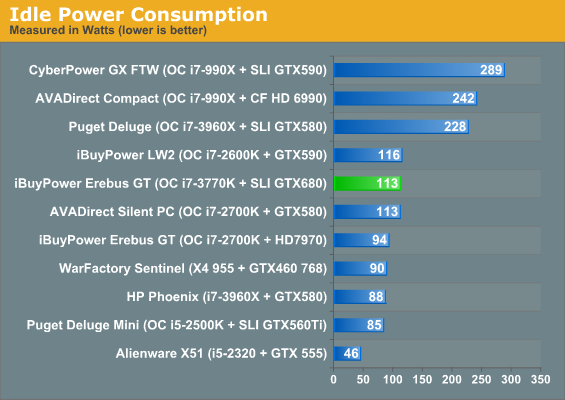

Power consumption is, frankly, outstanding. Intel's i7-3770K, at least overclocked where it is in this system, still sips power, and the pair of GTX 680s are able to provide performance comparable to or better than a pair of GTX 590s at roughly half the power draw.
As a result, I honestly feel like the 1.2kW PSU is absolute overkill for the Erebus GT. It simply doesn't need it; a 750W unit would've done the job with plenty of headroom to spare. This configuration is incredibly efficient for the performance you get, so there's no need to waste the extra money on a huge power supply.
Conclusion: Still a Solid Buy
My conclusions from the previous review of iBUYPOWER's Erebus GT are going to be echoed here: the system continues to be a solid value and worthy of enthusiast attention. What's also worth mentioning is that this review unit exhibited none of the issues I dealt with in the last one that merited the response from iBUYPOWER's Ricky Lee: it was solid from start to finish. Boutique systems tend to be a bit inflated in terms of price, but the Erebus GT is actually a good deal for an enthusiast looking for a liquid-cooled system but unwilling to actually wrestle with assembling one. Liquid-cooling the CPU is, at least in this reviewer's opinion, generally overrated unless you're really stressing it, but the video cards benefit from it in a major way.
I think the big story is actually Ivy Bridge and what it means to enthusiasts. Pretty much everyone else here has weighed in on it over the past few days, but as an enthusiast I'm a bit lukewarm to the i7-3770K. I feel like a lot of us were hoping for either a bigger performance improvement or better overclocking headroom due to the new process, but what we have instead is a chip that, when pushed to its conventional limits, is essentially still only the equal of its predecessor in terms of performance. It's difficult not to feel at least a little bit underwhelmed in that respect, but hopefully as Intel's 22nm process matures and new steppings become available, that overclocking headroom will improve and Ivy Bridge can fully supplant Sandy Bridge in the hearts and minds of enthusiasts. Such is the nature of Intel's "ticks", I suppose—Penryn and Westmere didn't exactly set the world on fire with improved performance.
On the other hand, where Ivy Bridge and Kepler do offer a substantial improvement over Sandy Bridge and Fermi is in performance-per-watt. This Erebus GT is hands down the most efficient gaming desktop we've ever tested, providing essentially the best quad-core performance and absolute best gaming performance we've ever seen while drawing less than 500 watts from the wall. When you're used to seeing gaming systems regularly draw far more than that, it's a big deal, and the best part is that idle power consumption is still entirely reasonable. This is one place where NVIDIA's and Intel's engineers can really be proud of themselves; Ivy Bridge may ultimately not provide enthusiasts any tangible performance advantage, but the power consumption advantage is undeniable.
In terms of gaming, the iBUYPOWER Erebus GT with Intel Core i7-3770K and pair of NVIDIA GeForce GTX 680s in SLI is the fastest system we've ever tested. CPU performance is essentially competitive, but tasks that benefit from additional cores are going to continue to prefer Gulftown and Sandy Bridge-E. Those are, I think, corner cases with benefits that for the majority of users won't outweigh the added expense and power consumption. The result here is that iBUYPOWER has produced a system with exceptional component choices, excellent power characteristics, and solid thermals. The Erebus GT as a chassis and cooling solution continues to be exceptional, and now it benefits from advances made by Intel and NVIDIA in recent months. That's worthy of a recommendation.

_thumb.jpg)
_thumb.jpg)
_thumb.jpg)
_thumb.jpg)
_thumb.jpg)
_thumb.jpg)






